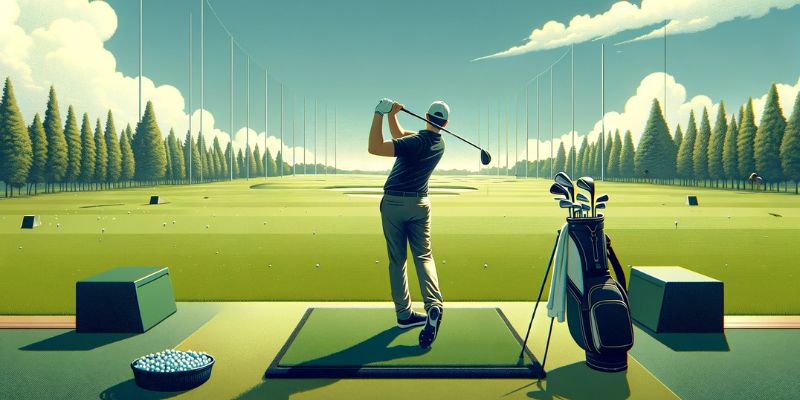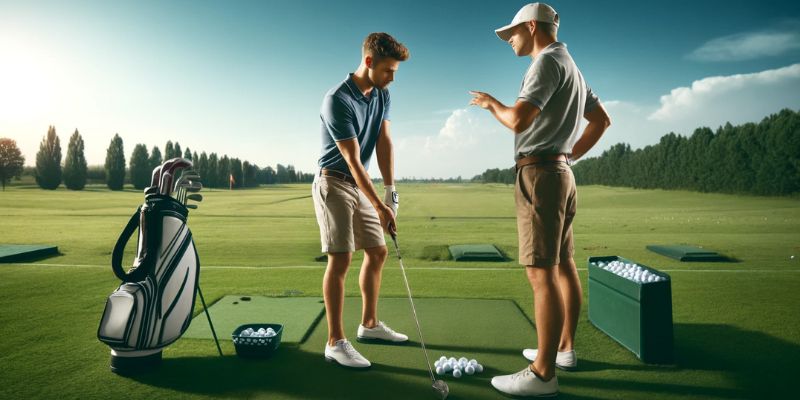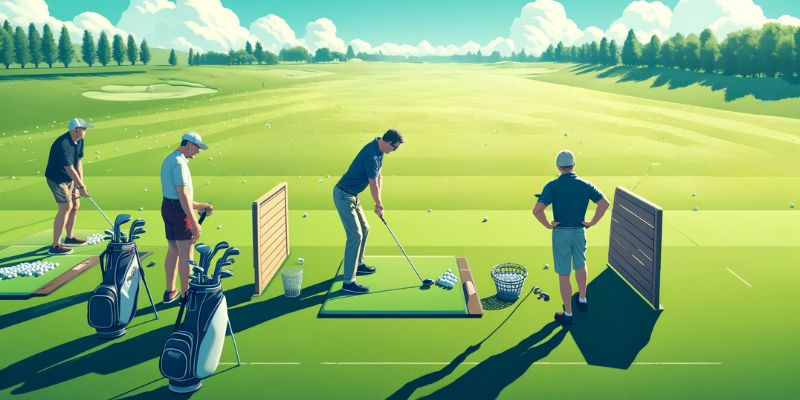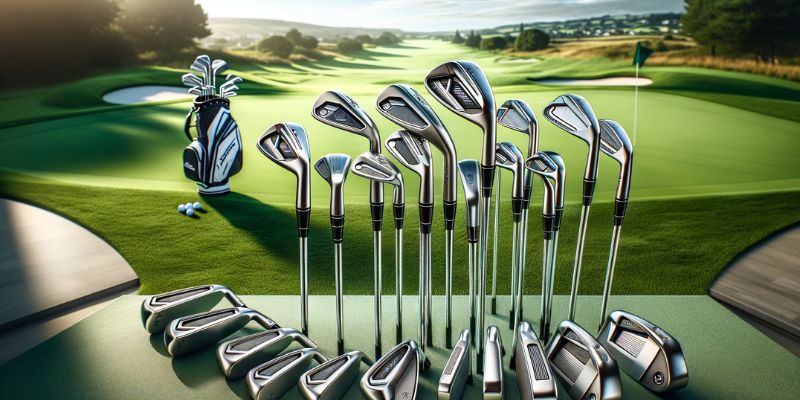
by Mark Preston | Jun 11, 2024 | Golf Equipment & Products - Reviews, Articles & Guides
Best practices for golf range sessions are crucial for players who want to enhance their game efficiently and effectively.
Hitting the range isn’t just about smashing golf balls towards the horizon.
It’s about focused improvement, deliberate practice, and feedback analysis.
A well-structured approach can significantly accelerate a golfer’s development and lead to noticeable improvements on the course.
Setting Effective Goals
When visiting the range, the first of the best practices for golf range sessions is setting clear, achievable goals.
Are you working on correcting a slice?
Improving your iron accuracy?
Or perhaps fine-tuning your swing speed?
Identifying specific areas to focus on can make your practice sessions more productive.
Goals should be SMART: Specific, Measurable, Achievable, Relevant, and Time-bound.
This framework helps maintain a clear focus and provides a standard against which you can measure your progress.
Essential Drills for Each Session
To maximize the effectiveness of your range time, incorporate drills that reinforce the fundamentals of golf while also addressing your specific improvement needs.
For instance, if you’re looking to enhance your swing tempo, drills like the pause-at-the-top drill can be particularly beneficial.
Similarly, if accuracy is your focus, target practice using alignment sticks can help fine-tune your aim.
Best practices for golf range sessions also include varying your golf club selection.
Don’t just stick to the driver; make sure to spend time with your irons and wedges, too.
Each club demands different skills and adapting your practice to include a range of clubs will prepare you for more situations on the course.
Reviewing Your Session Outcomes
Reviewing your practice session is as crucial as the session itself and stands out among best practices for golf range routines.
What did you learn? What improvements did you notice? What needs more work?
This reflection will help you adjust your goals and approach for future sessions, ensuring continuous improvement.
Technology can aid in this review process. Many modern ranges are equipped with launch monitors and video equipment.
These tools can provide immediate feedback on each shot’s distance, speed, angle, and accuracy, helping you understand the impact of small adjustments in real-time.
Effective practice at the golf range involves more than just hitting as many balls as you can.
By setting clear goals, practicing deliberately, and reviewing your outcomes, you can make each session a stepping stone to a better game.
How often should I practice at the golf range to see improvement?
Consistency is key in golf. Practicing at least 2-3 times a week can create noticeable improvements, especially when following best practices for golf range sessions.
What’s the ideal duration for a golf range session?
A productive session can last anywhere from 30 minutes to an hour. It’s more about quality and focus than duration. Longer sessions might lead to fatigue, which can compromise form and effectiveness.
Should I use range balls or my own for practice?
While range balls are adequate for general practice, using the same balls you play with can provide more accurate feedback on distance and flight path, aligning closer with the best practices for golf range efficiency.

by Mark Preston | Jun 11, 2024 | Golf Equipment & Products - Reviews, Articles & Guides
Club variety on your golf game isn’t just about having options; it’s about maximizing your potential on the course.
A golfer’s bag is like a chef’s knife set—each club serves a specific purpose and choosing the right one for the situation can make all the difference.
Whether you’re playing a casual round or competing in a tournament, integrating a variety of golf clubs into your game can significantly enhance your performance.
How Variety Helps Your Golf Play
The benefits of having a variety of clubs in your golf bag are numerous.
Club variety on your golf game allows for greater flexibility and adaptability to different types of shots and course conditions.
For instance, using a driver on a long, open fairway gives you the distance, but on a shorter hole or a fairway flanked by hazards, a fairway wood or iron may offer more control and accuracy.
Incorporating hybrids can also bridge the gaps between your irons and woods, providing a balance of distance and precision when you need it most.
Additionally, a selection of wedges can enhance your short game, allowing you to navigate tricky greens and bunkers effectively.
Mixing Clubs for Strategic Advantage
Strategic use of club variety on your golf game involves more than just reacting to the course layout.
It’s about pre-emptive thinking, understanding the strengths and weaknesses of your game, and planning your club choice accordingly.
For example, if you know you struggle with long irons, packing a few more hybrids might save you strokes.
Additionally, the conditions on the day of play should influence your club selections.
Windy conditions might necessitate lower-lofted clubs to keep the ball flight under control, while soft, wet courses might allow you to use clubs that give you a higher trajectory to stop the ball quickly on the greens.
Golf Clubs That Offer the Most Versatility
When considering club variety on your golf game, some clubs are known for their versatility and should be staples in any golfer’s bag.
Hybrids, for example, can replace both woods and irons, providing a high level of utility from various lies.
A good wedge set is also crucial, as it can drastically improve your scoring ability within 100 yards of the green.
Driver adjustability is another feature that adds versatility.
Many modern drivers come with adjustable lofts and weights that can be customized to improve accuracy or maximize distance based on your needs for the day or the specific course you’re playing.
By strategically selecting and utilizing a variety of clubs, you can enhance your performance, adapt to any course, and potentially lower your scores.
Remember, in golf, sometimes the smallest adjustment in your bag can make the biggest difference in your game.
How many clubs should I carry for optimal variety?
The rules of golf allow you to carry up to 14 clubs. A balanced bag typically includes a mix of woods, irons, hybrids, wedges, and a putter. Adjusting which specific clubs within these categories to carry can optimize club variety on your golf game based on the course and conditions.
Can club variety improve my handicap?
Absolutely. The more options you have at your disposal, the better equipped you’ll be to handle different scenarios on the course. This adaptability can lead to better shot outcomes and lower scores.
Should beginners focus on club variety?
Yes, beginners should embrace club variety on their golf game as it teaches them about the different clubs and their uses, which is crucial for developing a comprehensive understanding of the game.

by Mark Preston | Jun 11, 2024 | Golf Equipment & Products - Reviews, Articles & Guides
Golf range routines are crucial for any golfer looking to improve their game.
Personalizing your practice sessions can transform a mundane, repetitive activity into a powerful tool for rapid improvement.
By tailoring each session to address specific weaknesses and reinforce strengths, you can make substantial progress in a shorter period.
Personalizing Golf Practice Sessions
Customizing your golf range routine begins with an honest assessment of your skills and identifying areas that need the most attention.
Whether it’s your driving, iron play, chipping, or putting each practice session should target these specific areas.
Vary your practice by focusing on different aspects of your game on different days.
This approach keeps the practice sessions engaging and prevents the plateau effect that can come from too much repetition of the same drills.
For instance, you might dedicate one day to working exclusively on your driving, adjusting your stance, swing speed, and technique, while another session might focus on short games, especially if that’s where you tend to drop shots during a round.
Key Golf Drills for Rapid Improvement
Incorporating a variety of drills into your golf range routine is key to rapid improvement.
One effective drill is the “10-ball run.” Here, you hit 10 balls with each golf club, aiming to land each ball within a predetermined target area.
This drill enhances accuracy and consistency, which are critical under game pressure.
Another great exercise is the “distance control” drill for your irons.
Set up targets at different distances and practice hitting each with the appropriate iron.
This not only helps with distance control but also improves your ability to select the right club during a game.
Measuring Your Progress Effectively
Tracking progress is an essential part of any effective golf range routine.
Without it, it’s difficult to know if your practice is paying off.
Use technology to your advantage—many modern driving ranges are equipped with radar systems that measure ball speed, flight path, and distance.
Apps and gadgets can also track your accuracy and consistency over time.
Additionally, keep a practice journal.
Log what drills you do, the number of shots, what went well, and what needs improvement.
Reviewing this journal can help you adjust your practice plan and stay focused on your goals.
With the right golf range routine, personalized to your needs and diligently followed, you’ll find yourself getting better not just incrementally, but exponentially.
Keep your practices dynamic, targeted, and enjoyable, and watch as your game transforms on the golf course.
How often should I change my golf range routine?
You should tweak your golf range routine every few weeks or as soon as you feel that certain aspects of your game are no longer challenging. This helps to keep your practice sessions fresh and ensures that all areas of your game are being developed.
What’s the best way to start personalizing my golf range routine?
Begin by identifying the weakest parts of your game through self-assessment or with a coach’s help. Then, design your practice sessions around improving these areas with specific drills that challenge these weaknesses.
How do I know if my golf range routine is effective?
An effective golf range routine leads to noticeable improvements on the course. If your routine is working, you should see better shot accuracy, consistency, and ultimately, lower scores. Also, tracking progress through measurable data can give you a clear indication of improvement.

by Mark Preston | Jun 11, 2024 | Golf Equipment & Products - Reviews, Articles & Guides
Practice with fewer golf clubs may seem counterintuitive when your golf bag comfortably holds up to fourteen.
Yet, many seasoned golf instructors argue that this minimalist approach can significantly enhance your focus and skill development on the range.
Focusing Your Skills
By practicing with fewer clubs, golfers can concentrate deeply on mastering each club’s unique mechanics and potential uses.
This focused practice leads to a better understanding of each club’s influence on ball flight, distance, and accuracy.
When you limit your options, you are compelled to think more strategically about each shot, leading to improved problem-solving skills on the course.
Practice with fewer clubs encourages a golfer to adapt to different scenarios using a limited set of tools, mirroring situations that often occur during actual play where the perfect club might not always be at hand.
Benefits of Minimalist Practice
The minimalist approach to golf practice offers several benefits.
Firstly, it reduces decision fatigue. Carrying a full set can overwhelm beginners and intermediate players with choices.
By focusing on just a few clubs during practice sessions, you simplify the learning process and increase the quality of practice. Secondly, using fewer clubs can help improve your creativity and versatility.
For example, learning to use a 7-iron for various shots and distances can enhance your adaptability, a crucial skill in golf.
Moreover, practice with fewer clubs in your routine can lead to better physical endurance and swing consistency.
Swinging the same few clubs repeatedly helps in refining your swing mechanics and building muscle memory.
This consistent repetition with a select few can yield quicker improvements in swing technique compared to rotating through a full set.
How to Choose Which Clubs to Use
Selecting which clubs to include in your minimalist practice is essential.
Ideally, choose a club from each category: a driver or wood, an iron, and a wedge.
This selection covers a broad range of shots you’ll encounter on the course.
For instance, use the driver for practicing tee shots, the iron for mid-range and approach shots, and the wedge for short game around the greens.
It’s also beneficial to practice with clubs you struggle with or those crucial for upcoming courses you plan to play.
If a particular course is known for its long par-3s, include a long iron or hybrid to your limited set to hone the necessary skills.
Practice with fewer clubs not only simplifies your training but profoundly impacts your performance, making every swing on the course count with greater confidence and precision.
Why should I limit the number of clubs during practice?
Limiting your clubs during practice helps to improve focus, increase mastery, and enhance creativity by forcing you to use a club in various scenarios.
Can practicing with fewer clubs improve my score?
Yes, focusing your practice on fewer clubs can improve your score by building better familiarity and confidence with those clubs, which translates into more consistent and accurate shots on the course.
How do I choose the right clubs for minimalist practice?
Select clubs that offer a range of uses and cover different distances. Include a wood or driver, an iron, and a wedge to ensure you can practice a variety of shots.

by Mark Preston | Jun 10, 2024 | Golf Equipment & Products - Reviews, Articles & Guides
For many golfers, the visual appeal of their clubs plays a significant role in their choice of equipment.
The aesthetics of golf irons are more than just a matter of personal taste; they can also impact confidence, comfort, and ultimately, performance on the course.
Visual Impact on Game
The aesthetics of golf irons can profoundly affect a player’s game.
When you stand over a shot feeling confident and pleased with the visual appeal of your club, it can positively influence your mental state and focus.
This psychological comfort can lead to smoother swings and better overall performance.
Golf is as much a mental game as it is a physical one, and feeling good about the tools in your hands can make a significant difference.
Additionally, the design and finish of golf irons can help with alignment and provide better visibility against various backgrounds.
Sleek lines and a clean finish can help focus the eye and improve aim, while a clunky or visually unappealing iron might distract or detract from focus.
Customizing the Look of Your Irons
In today’s market, the options for customizing the aesthetics of golf irons are almost limitless.
Golfers can choose from a range of colors, finishes, and materials to make their clubs stand out or better match their personal style.
From the classic polished steel to modern matte finishes and even vibrant colors, there are irons designed to suit every aesthetic preference.
Customization doesn’t stop at cosmetics.
Many manufacturers offer engraving services to add initials, logos, or other personal touches that make the clubs uniquely yours.
This level of personalization not only enhances the visual appeal but also can create a deeper connection to the equipment, making each round of golf that much more special.
Style vs. Performance
While the aesthetics of golf irons are important, it’s crucial to balance style with performance.
The best-looking iron might catch your eye, but if it doesn’t perform well with your playing style, it won’t help lower your scores.
When selecting golf irons, it’s essential to consider factors like the clubhead design, shaft material, and grip, alongside the visual aspects.
Golfers should try various iron models to see which ones not only appeal visually but also enhance their gameplay.
Some might prefer the traditional look and feel of blade irons, while others may opt for the modern and sleek design of cavity-backs that offer more forgiveness.
The key is finding a balance that satisfies both the eyes and the game’s demands.
Embracing the aesthetics of golf irons while keeping performance in mind allows golfers to enjoy the best of both worlds, ensuring they play well and in style.
Does the color of golf irons make a difference?
While the color of golf irons doesn’t affect the performance, it can influence a player’s choice based on visual preference and comfort. Brighter colors may be easier to see, while traditional finishes typically appeal to those who appreciate a classic look.
Can the finish of a golf iron impact its durability?
Yes, different finishes can affect the longevity and maintenance needs of golf irons. For example, a chrome finish might resist wear and rust better than a raw or matte finish.
Should I choose golf irons based on looks or performance?
While aesthetics are important, performance should be the primary consideration when choosing golf irons. Ensure the irons suit your skill level and playing style to optimize your performance on the course.





